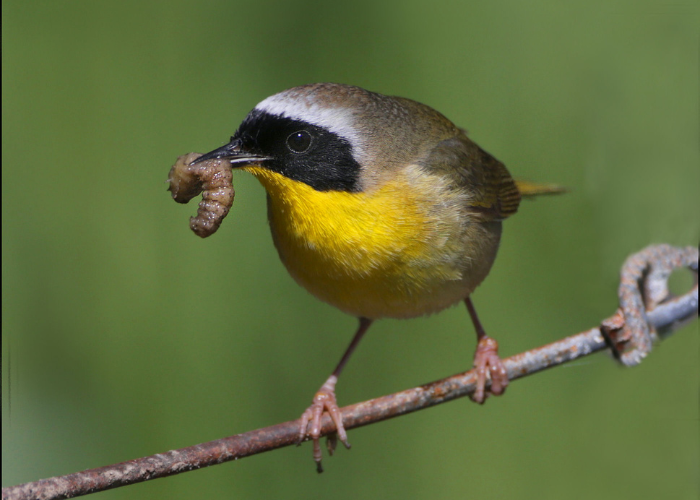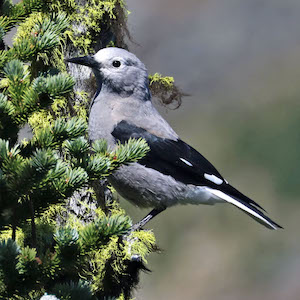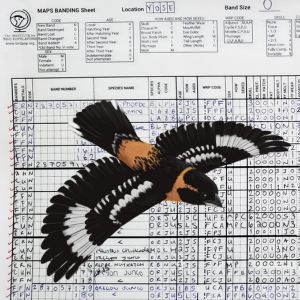Imagine you are on a cross-country bike trip from Florida to Vermont. You’ve pedaled for weeks, sustained by the thought of the massive maple-glazed cinnamon roll you’ll eat at your favorite diner in Burlington. The diner closes for the summer in late May, so you’ve timed your trip carefully. Finally, you roll up to the diner, walk to the door on shaky, exhausted legs, and find a sign reading: “We’ve decided to close early this year. See you after Labor Day!” NO! This tragic instance of bad timing is what ecologists call a “phenological mismatch” -phenology refers to the timing of seasonal biological events. Migratory birds are experiencing phenological mismatch more frequently as warming trends lead to earlier springs.
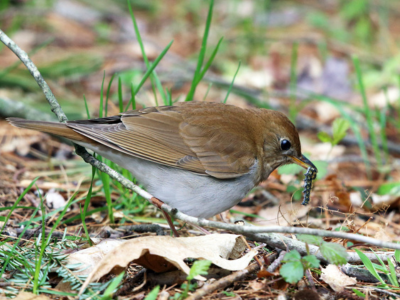
A Veery finds a caterpillar in the leaf litter. Photo by Tom Murray.
Migratory birds travel huge distances to high latitudes to take advantage of the bounty of nourishing insects, especially fat caterpillars, that accompany spring in these regions. These insects provide the resources they need to feed their young, and arriving too late can be detrimental. Rather than merely a low blood sugar induced tantrum from missing out on your favorite maple cinnamon roll, birds that don’t breed when the insect flush is in full swing may have fewer offspring.
A recent study in the Journal of Animal Ecology examined how changes in the timing of spring affects 3 different trophic levels in the eastern temperate forest of North America: trees, caterpillars, and birds. This study represents a large collaboration between researchers at 7 different institutions that relied on databases compiled by hundreds of individuals across the continent- including MAPS banders!
The study used 4 types of data to explore the relationship between the onset of spring, deciduous trees, the flush of caterpillars, the arrival, and the initiation of breeding by migratory birds between 2002 and 2017. The arrival of spring was quantified as the accumulation of “Growing Degree Days” or— a measure of the amount of heat available to plants and insects for growth. The researchers used MODIS satellite imagery from NASA to measure when trees began to “green-up” or leaf-out in Eastern North America at a 500m spatial resolution. Citizen science data on butterfly abundance was used to estimate the emergence of caterpillars because there is little data that directly measures caterpillar phenology. The arrival of migratory birds was estimated using eBird data- another citizen science effort.
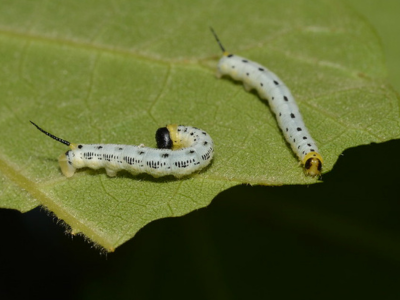
Catalpa Sphinx Moth caterpillars. Photo by Andy Reago and Chrissy McClarren.
The timing of breeding for these migratory birds was calculated using data from the MAPS program- the researchers used the average date of capture across all juvenile birds of a particular species at a given banding location in a given year. Lead author of the study, Dr. Michael Belitz, says the MAPS data was unique in its spatial specificity:
The MAPS dataset was instrumental to this study and our estimates of the timing of breeding bird phenology would not have been possible without it. The MAPS dataset was also unique in our study, because it was the only phenological event that could be estimated at a precise spatial resolution. Due to the unstructured or semi-structured format of the data used to estimate Lepidoptera emergence and bird arrival, we needed to aggregate data to large hexagonal cells. However, breeding phenology could be estimated at a station-specific resolution due to the repeated and standardized protocol being followed by MAPS banders.
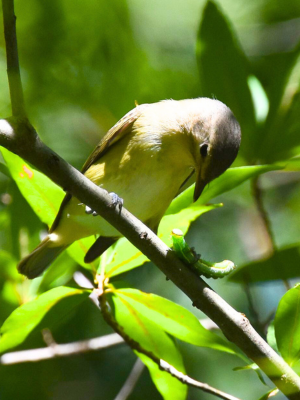
A vireo grasps a caterpillar with its foot. Photo by Andy Reago and Chrissy McClarren.
The study found that trees and insects tracked the timing of spring pretty closely. If enough growing degree days accumulated earlier than in a typical year, trees were able to leaf out early, and butterflies and moths reproduced earlier. This makes sense because plants and insects are ectotherms and sensitive to local temperatures. Migratory birds, however, are traveling from the non-breeding grounds and not experiencing conditions on the breeding grounds. Their timing is more dependent on proxy clues to conditions on the breeding grounds, like day length. If spring came early, they arrived earlier and bred earlier, but not earlier enough to align well with the caterpillar boom.
Study co-author Dr. Casey Youngflesh says that this study is one of the few to examine phenology across three trophic levels- most only consider one or two levels. One of his previous studies that examined two trophic levels, trees and birds, found that across North America, bird breeding phenology did not keep pace with changes in the timing of spring green-up and that phenological mismatch resulted in lower reproductive output in the birds. The addition of a third trophic level- insects- in the current study is critical, says Youngflesh, because the link between birds and caterpillars might be more concerning than the link between caterpillars and plants, in terms of any decoupling in the timing of seasonal events. Belitz notes that a study involving this many groups of organisms across this large a geographical area is only possible because of a huge collaborative effort.
Previous work has documented that forest green-up, Lepidoptera (butterflies and moths) emergence, and bird phenology have been responding differently to climate change. However, these studies have largely occurred at smaller spatial scales because data on insect phenology is scarce. Our study draws upon techniques that have been developed by co-authors of the study working on forest, insect, and bird phenology for over a decade. By leveraging a decade of collaborative experience, we were able to take a data synthesis approach to compare how much the timing of forest green-up, Lepidoptera emergence, migratory bird arrival, and bird breeding has changed in response to changes in spring temperature accumulation across eastern North America. Our results add to the evidence that birds are not tracking climate changes to the same degree as insects and plants, particularly in northern latitudes.
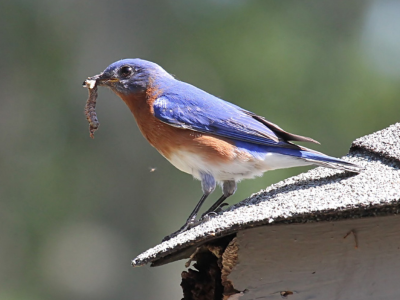
An Eastern Bluebird brings its nestlings a meal of caterpillar. Photo by John Flannery.
This study highlights the critical importance of reversing insect declines, not only to conserve insects themselves but also to support healthy bird populations. A recent paper in the journal Science, found that total butterfly abundance in the US declined by 22% between 2000 and 2020. Phenological mismatch has been proposed as one of the possible causes of widespread population declines of both birds and insects. To better understand its role, and what we can do ameliorate its effects on these species, we need to gather more long-term data on insect phenology and abundance on large geographical scales. We also need to continue collecting critical bird demographic data through the MAPS program. The MAPS database is a unique dataset that is increasingly used by researchers investigating a wide variety of conservation questions.


